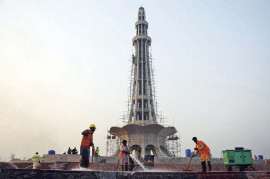
Despite continuous efforts over the past few decades to promote tourism in the country, so that it can help the economy and promote a soft image, development of tourism infrastructure has largely remained unambitious.
Even when the promotion of religious tourism has taken centre stage in governmental policies, a majority of the historical and religious sites are not only difficult to reach but many also lack basic amenities like restrooms. Hassan Hayat, a sightseer from Lahore, while talking to The Express Tribune conveyed his frustration at the lack of public transport options to travel to many of the country’s ancient religious sites.
“There are only a few cities, such as Lahore, Nankana Sahib, Multan, and Kasur, where public transportation is accessible for visiting holy sites; however, if you wish to travel from Lahore to Kartarpur or Katas Raj, you have to have a car or must rent one,” he said, adding that rent-a-car companies charge an arm and a leg. Hayat further informed that places like Kartarpur and Katas Raj do not have any lodging options so people from other cities get deterred by it.
Similarly, Imran Ali, a travel enthusiast who enjoys exploring religious sites, agreed. “I have been to nearly all of Pakistan’s significant historic and holy places and public transport was not available for 80% of them.” Ali, whilst recalling his experiences fondly, said that a shared feature in all of the sites he visited was the lack of functional restrooms and exploitative lodging and food prices. “Even the road infrastructure is quite poor. Like the main road leading to Kartarpur Sahib has massive potholes. Furthermore, some sites of Hindus and Jains are completely devoid of any governmental attention. So we are a long way off from promoting tourism,” Ali opined. Archaeologist and former director of Punjab Archeology, Afzal Khan, was of the view that even though some religious sites of Sikhs, Hindus, Jains, and Buddhists have been developed in recent times “many of them are still in a state of deterioration and will likely become unsalvageable in the near future.” Khan further said that the real potential of religious tourism in the country remained unexplored.
As per Jameel Raza, a well-known tour guide from Lahore, the only way to tap into this potential is by listening to tourists’ expectations. “Some crucial factors for sightseers are: How safe the place is and how simple it is to get to? What services, such as tour guides, are offered locally and how welcoming are the locals to visitors? Likewise, how well-organised the local transportation options are and the availability of a health care system?” Raza was of the view that until such expectations are addressed, tourism in the country would never grow. “Most of our tourist destinations overcharge and mistreat visitors. They lack basic amenities. So vacations usually become horror stories.” Secretary Tourism Punjab, Ehsan Bhutta, when asked about the lack of practical measures taken to promote tourism, said that the department was working on it.
“There is now a tour service available for visiting Muslim Sufi shrines, particularly those of the prominent Sufis of South Punjab.” He further said that steps were being taken to promote religious tourism for Sikhs, Hindus, and other religions as well. “A special bus service has been launched from Rawalpindi for Buddhist travellers to visit their holy sites. We are also arranging tours from Lahore to Kartarpur, Katas Raj, and Hasan Abdal,” Bhutta informed while talking to The Express Tribune.




1736856635-0/BeFunky-collage-(47)1736856635-0-165x106.webp)
1736854876-0/Untitled-design-(80)1736854876-0-165x106.webp)







1636187892-4/Amir-Khan,-KPK-Tourism-(4)1636187892-4-270x192.webp)

1732012115-0/Untitled-design-(14)1732012115-0-270x192.webp)


1736765990-0/fizza-(14)1736765990-0-270x192.webp)








COMMENTS
Comments are moderated and generally will be posted if they are on-topic and not abusive.
For more information, please see our Comments FAQ